Explore the Unique Wildlife of Eastern Hokkaido:
Where to Find Them and Their Rarity!
Where to Find Them and Their Rarity!
Publication Date:2024.11.01
Last Updated:2025.05.10
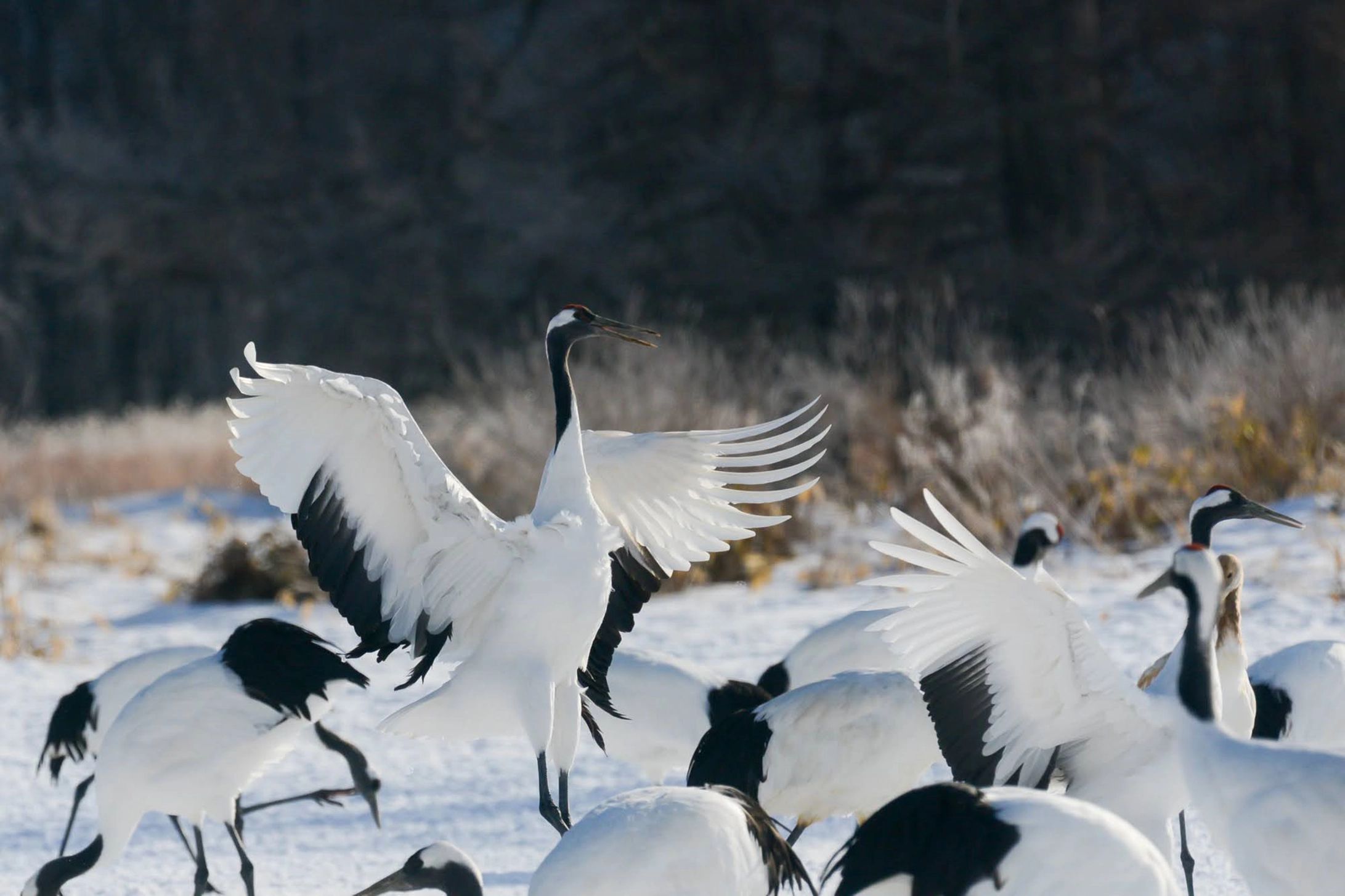
Contents
01
Basic Information about Eastern Hokkaido
On the eastern side of Hokkaido lies Eastern Hokkaido (Doto), a
region where vast natural landscapes unfold. Often referred to as
"Japan's hidden gem," Eastern Hokkaido is one of the few areas
where untouched nature still remains. Due to the abundance of
places where humans rarely venture, it is a unique region where
numerous rare wildlife species live in their natural form.
Hokkaido is famous for its diverse range of animals, including the
Ezo red fox, Ezo deer, as well as the Japanese cranes and
Steller's sea eagle and White-tailed eagle, which are designated
as natural monuments. This time, from a local's perspective, we
will introduce the animals you can see and the locations where
they appear, ranked by rarity. If you manage to see them all,
consider yourself truly lucky!
02
Tips and Recommended Clothing
Hokkaido is home to a wide variety of wildlife, and as the name
suggests, these animals live in their natural, "wild" state. If
you approach them too closely, simply because they are cute or you
want a better look, there is a risk of disrupting the ecosystem or
causing injury and accidents. Moreover, there are countless cases
where wildlife has died due to being fed by tourists. It is
crucial never to feed them. Observe the unique wildlife of Eastern
Hokkaido from a respectful distance, always keeping a clear
boundary in mind. Information about wildlife can be obtained from
the "Kushiro Wetland Wildlife Center" and the "Shiretoko Rausu
Visitor Center." Additionally, birdwatching facilities in various
areas make it easy to enjoy birdwatching, and they come highly
recommended. During the winter season, as you might find yourself
walking in freezing cold conditions, be sure to prepare adequately
with warm clothes, snowshoes, hats, gloves, and scarves to keep
your skin protected.
03
Introduction to Wildlife
Ezo deer
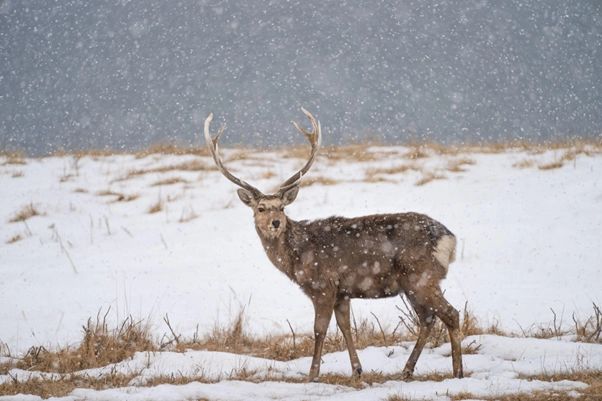
One of the representative wild animals of Hokkaido, the Ezo
deer, is frequently spotted. They are larger than the Japanese
deer found in Honshu, with males growing up to 190 cm in length
and weighing up to 150 kg. To withstand Hokkaido's cold climate,
their muscle mass is two to three times that of the Japanese
deer, giving them a robust appearance. The population of Ezo
deer has been increasing due to their high reproductive rate and
recent environmental changes. They often live in rich, natural
forests and mountains, and you have a high chance of
encountering them when driving through Eastern Hokkaido. There
are numerous "Watch Out for Deer" signs throughout Eastern
Hokkaido, as they can unexpectedly jump onto the road, so
caution is advised. It is especially recommended to be vigilant
when driving from late afternoon to night, as they are more
active at these times.
Additionally, Ezo deer have long been a valuable source of food in game cuisine. They are rich in protein and iron and have low fat content, making them a popular, healthy ingredient. Various restaurants across Eastern Hokkaido offer game dishes, and you can enjoy them alongside Ainu cuisine in the Akanko Onsen area, which has settlements of the indigenous Ainu people.
Additionally, Ezo deer have long been a valuable source of food in game cuisine. They are rich in protein and iron and have low fat content, making them a popular, healthy ingredient. Various restaurants across Eastern Hokkaido offer game dishes, and you can enjoy them alongside Ainu cuisine in the Akanko Onsen area, which has settlements of the indigenous Ainu people.
1.Places/Times to See Them
While Ezo deer can be seen year-round, the best season is
autumn. Around the Shiretoko Peninsula, you have a high
probability of encountering wild Ezo deer. For those who
definitely want to see Ezo deer, the "Shiretoko Ezo Deer Farm"
in Shari Town is recommended. Here, you can observe Ezo deer
raised in a dedicated ranch up close.
2.Highlights
Autumn is the season when the male Ezo deer's antlers are at
their most beautiful, and you might witness males clashing
antlers. You might also see their charming side as they
exhibit a flehmen response, which looks like a smiling
expression, as part of their mating behavior. It's also highly
likely you'll see parent and child Ezo deer foraging for food
in the forest.
Rarity
★☆☆☆☆ (Frequently seen)
★☆☆☆☆ (Frequently seen)
Ezo red fox
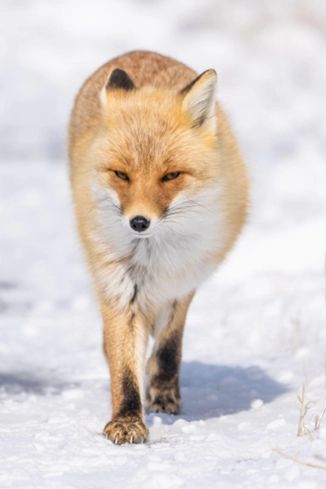
The Ezo red fox, a representative animal of Hokkaido, has gained
fame through dramas and movies. While they inhabit all of
Hokkaido, you're particularly likely to encounter wild Ezo red
foxes in the nature-rich area of Eastern Hokkaido. In winter,
their fluffy winter coats make them look adorable and
heartwarming. However, despite their cuteness, it is absolutely
forbidden to touch them. Ezo red foxes can carry a parasitic
disease known as echinococcosis, and in Hokkaido, children are
taught from elementary school to never touch them. Remember that
they are still wild animals, so enjoy watching them from a safe
distance. Additionally, natural spring water may contain
echinococcosis, so it’s best to avoid drinking from springs that
have not been tested for water quality.
1.Places/Times to See Them
Ezo red foxes can be seen throughout Eastern Hokkaido
regardless of the season. They may suddenly dart out while
you're driving, so caution is advised. For those who
definitely want to see Ezo red foxes, the "Kita Kitsune Farm"
in Kitami's Rubeshibe Town is recommended. Here, about 60
foxes, having undergone measures against echinococcosis, roam
freely in a natural setting, allowing you to see their
adorable selves year-round. The "Abashiri-Kitami Sightseeing
Bus" offers tours that visit the Kita Kitsune Farm while
exploring tourist spots in Abashiri and Kitami. This plan is
recommended for those who prefer convenient mobility.
Abashiri Bus "Abashiri-Kitami Sightseeing Bus"
2.Highlights
Ezo red foxes are agile, and you can watch them scampering
across grasslands and snowfields. Sometimes, you might catch a
glimpse of them grooming each other or napping in family
groups. In summer, they have less fur, giving them a sleek
appearance, whereas in winter, their fluffy coats make them
appear rounder. Among them, there are "cross foxes,"
characterized by cross-shaped markings on their bodies, but
the chance of seeing one is less than 1%. Consider yourself
lucky if you do spot one!
Rarity
★☆☆☆☆ (Quite likely to encounter)
★☆☆☆☆ (Quite likely to encounter)
Ezo squirrel
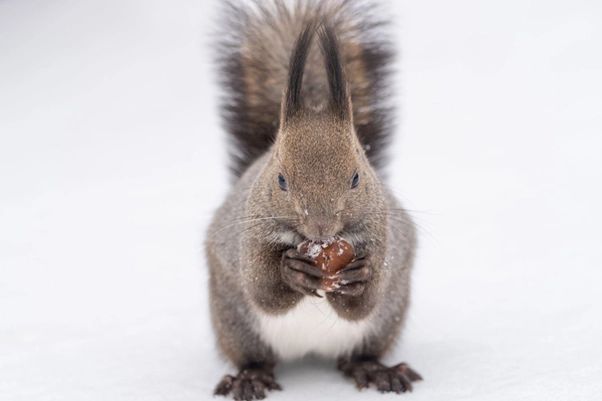
The Ezo squirrel, known for its adorable appearance, can be
found throughout Hokkaido. With a body length of about 22 to 27
cm, they are relatively large, and their fluffy tails add to
their popularity. While they are generally active throughout the
day, the best chance to spot them is around sunrise. They
inhabit not only vast natural settings but also urban parks.
Since they dart swiftly between trees, focusing on tree trunks
might make it easier to spot them. In winter, they grow even
fluffier to protect themselves from the cold, doubling their
cuteness.
1.Places/Times to See Them
Ezo squirrels can be spotted year-round and almost anywhere.
They are most active around sunrise, so getting up early for a
morning walk is recommended. In the fall, when the leaves drop
and they scurry around searching for walnuts, your chances of
spotting them increase significantly.
2.Highlights
The Ezo squirrel is charming with its bushy tail, perked-up
ears, and white belly fur. In autumn, you might observe them
burying nuts that they will eat during winter. Their fur
changes from brown in summer to grayish-brown in winter, which
is another distinctive feature. Watching them energetically
dash around snowfields is reminiscent of playful children.
Rarity
★☆☆☆☆ (Might be a bit challenging to spot due to their agility)
★☆☆☆☆ (Might be a bit challenging to spot due to their agility)
Red-crowned crane
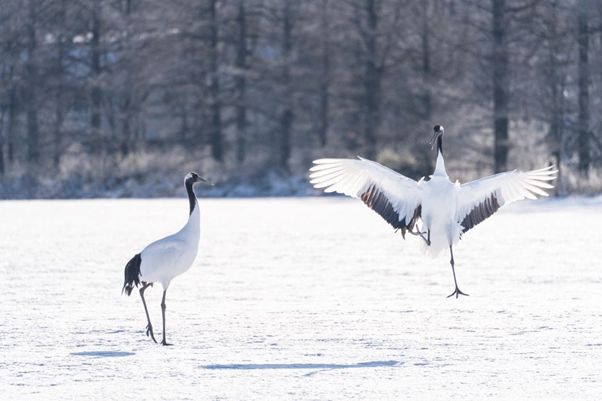
The red-crowned crane, designated as "The Bird of Hokkaido," is
a large crane measuring around 140 cm in length. It is known for
its beautiful pure white body and distinctive red crown.
Although these cranes once lived throughout Hokkaido, habitat
loss due to the island’s development and overhunting led to the
belief that they had become extinct. However, they were later
rediscovered, and through dedicated conservation efforts by
local volunteers, their population has increased to over 1,500.
This rare bird has been designated as a special natural
monument.
1.Places/Times to See Them
About a 50-minute drive from Kushiro City, Tsurui Village,
surrounded by the Kushiro Wetlands, is a wintering site for
these cranes. From November to March, you have a high chance
of seeing them at the Tsurumidai feeding station, where they
are often fed corn. Akan Bus offers a convenient plan that
includes a round-trip bus ticket from Kushiro Station to
Tsurumidai and a lunch, making it highly recommended.
Additionally, the Tsurui-Ito Tancho Sanctuary attracts nearly 300 cranes annually to its feeding grounds. For those wanting to see them in summer, the Kushiro City Tancho Crane Natural Park is recommended, offering observations of cranes living vibrantly in a more natural environment.
Additionally, the Tsurui-Ito Tancho Sanctuary attracts nearly 300 cranes annually to its feeding grounds. For those wanting to see them in summer, the Kushiro City Tancho Crane Natural Park is recommended, offering observations of cranes living vibrantly in a more natural environment.
Round-Trip Bus Tickets to Tsurumidai and Lunch Set Ticket at
Doremifa-sora
2.Highlights
The red-crowned crane is stunningly elegant, and its posture
is exceptionally beautiful. The sight of cranes quietly
standing on vast, snow-covered fields is truly enchanting.
Watching them arrive in flocks and slowly walk while
stretching upward is a mesmerizing experience. In February,
you might even witness the courtship dance, where they spread
their wings wide in a magnificent display.
Rarity
★★☆☆☆ (Select the right locations to increase your chance of seeing them!)
★★☆☆☆ (Select the right locations to increase your chance of seeing them!)
Steller's sea eagle and White-tailed eagle
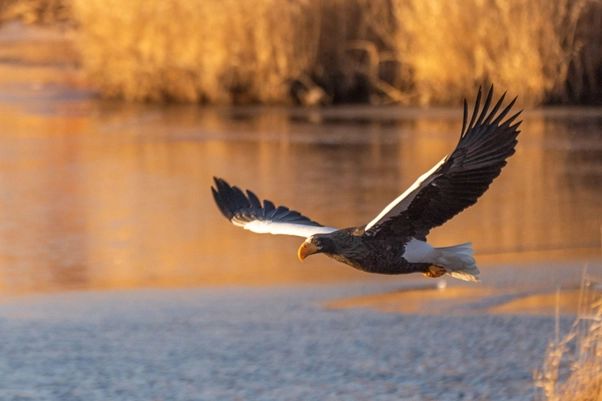
During winter, these magnificent raptors migrate from Siberia to
Hokkaido to overwinter. With wingspans exceeding 2 meters, they
are among the largest birds of prey seen in Japan. They are
classified as endangered species, making them exceptionally
rare. Primarily fish-eaters, these eagles can often be spotted
near coastlines, rivers, and lakes. Numerous birdwatching tours
are organized during winter to observe these eagles, and joining
a tour is highly recommended.
1.Places/Times to See Them
The eagles arrive in Hokkaido around late October, when the
water begins to freeze, and they return to Russia by early
March. The peak of their arrival is typically in February,
coinciding with the drift ice season. They often perch atop
tall trees with clear views over water, hunting for prey. For
those who wish to ensure sightings of Steller's and
White-tailed Eagles, a sightseeing boat tour in the Rausu area
is highly recommended. The tours offer nearly a 100% encounter
rate due to feeding activities conducted for conservation
purposes, allowing for up-close birdwatching experiences.
2.Highlights
The sight of these eagles swooping down with their huge wings
over the water, or soaring against the backdrop of Eastern
Hokkaido's majestic landscape, is truly impressive. Sometimes,
they can be seen resting in snowy fields or on frozen lakes.
For a closer look at the striking features of these eagles,
using binoculars or a telescope is recommended. Steller's Sea
Eagle has a large, vivid yellow beak with distinct black and
white plumage, while the White-tailed Eagle is characterized
by a slightly paler yellow and smaller beak.
Rarity
★★☆☆☆ (High chance of encounters on tours!)
★★☆☆☆ (High chance of encounters on tours!)
Shima-Enaga
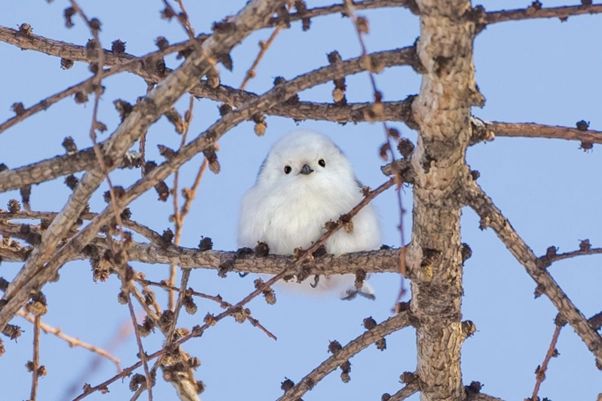
Also known as the "snow fairy" of Hokkaido, the Shima-Enaga is a
tiny bird, measuring about 10 to 14 cm, making it one of the
smallest in Japan. They usually live in flocks of 5 to 10 and
are adored for their cotton-like white bodies and round eyes,
which make them particularly popular among children. Their diet
consists mainly of tree sap, small berries, and insects. They
are typically found in forests and woodlands. In Japan, they are
native only to Hokkaido, and in the nature-rich area of Eastern
Hokkaido, you might spot them on occasion.
1.Places/Times to See Them
The best season to spot Shima-Enaga is during the winter
months, from December to February. Because they live in
forests, they are hard to find in the summer when the leaves
are dense. They can be seen in areas with many trees, and with
a bit of luck, even in some urban areas. Since Shima-Enaga are
quick and agile, relying on their high-pitched calls of
"chee-chee" or "pee-pee" may help in locating them.
2.Highlights
Their fluffy, cute white bodies are irresistibly endearing,
especially popular among birdwatchers. Interestingly, their
appearance differs between summer and winter, with their
bodies being completely white only in the winter months. To
survive the harsh cold, they are covered with fluffy feathers
that trap air. You might see them perching on branches with
tilted heads or swiftly darting about. Joining a birdwatching
tour is also recommended, but remember to bring snowshoes as
some areas may be deep with snow.
Rarity
★★★★☆ (Difficult to spot due to their small size and agility)
★★★★☆ (Difficult to spot due to their small size and agility)
Sea otter
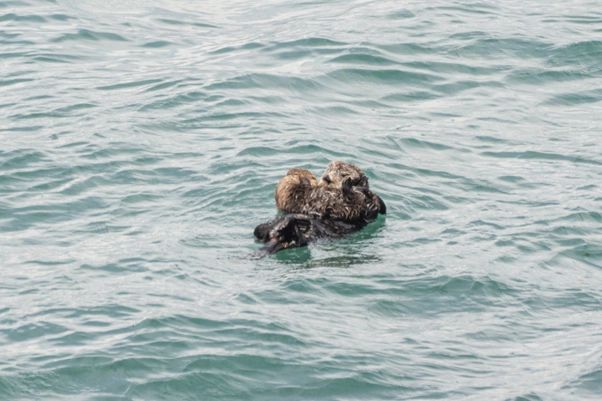
Famous for their image of cracking shells with stones, sea
otters have recently become a topic of interest as a few have
settled around Cape Kiritappu in Hokkaido. Once hunted to near
extinction, their global population dwindled to about 2,000,
placing them on the endangered species list. Around 2016, about
three sea otters began settling at Cape Kiritappu. By 2023, four
mother-child pairs had been confirmed, indicating a baby boom.
The adorable appearance of sea otters draws many visitors to the
cape. They can also be spotted from Cape Nosappu at the tip of
the Nemuro Peninsula.
1.Places/Times to See Them
Sea otters can be seen year-round, showcasing their charming
appearances in any season. From the cliff-top promenade at
Cape Kiritappu, you can watch the otters below. It is
particularly recommended to visit on clear, fog-free days or
when the waves are calm. Binoculars are essential for those
who wish to have a good view of the otters floating on the
water’s surface.
2.Highlights
You can observe sea otters resting closely together on safe
rocky shores or a parent swimming with a baby on its belly.
Newborns are extremely fluffy, and watching a mother sea otter
tightly cuddling her young is sure to be a heartwarming
experience. Since otters are sensitive to sound, it's
important to quietly observe them without creating loud
noises.
Rarity
★★★★★ (Given their small numbers, you're really lucky if you happen to see one!!)
★★★★★ (Given their small numbers, you're really lucky if you happen to see one!!)
04
Summary
In Eastern Hokkaido, vast and untouched natural landscapes still
spread out. It's in places like this where you can encounter
animals living in their natural state. The unique chance to feel
the immense scale of nature and the breath of coexisting animals
up close is something only Eastern Hokkaido offers. The excitement
of encountering rare animals will undoubtedly become a memorable
experience. So, why not come and enjoy meeting the rare wildlife
in the great outdoors?
Writer Information

Naeka Okumura
Naeka Okumura, born in 1994, hails from Kitami City, Hokkaido. Worked for six years at a financial institution within Hokkaido. Later joined a video production company, Hokuei Northern Films, in Kitami City as a chief manager and writer. Resigned in 2023 and became independent as a copywriter and journalist writer under the name Produce One.
Naeka Okumura, born in 1994, hails from Kitami City, Hokkaido. Worked for six years at a financial institution within Hokkaido. Later joined a video production company, Hokuei Northern Films, in Kitami City as a chief manager and writer. Resigned in 2023 and became independent as a copywriter and journalist writer under the name Produce One.